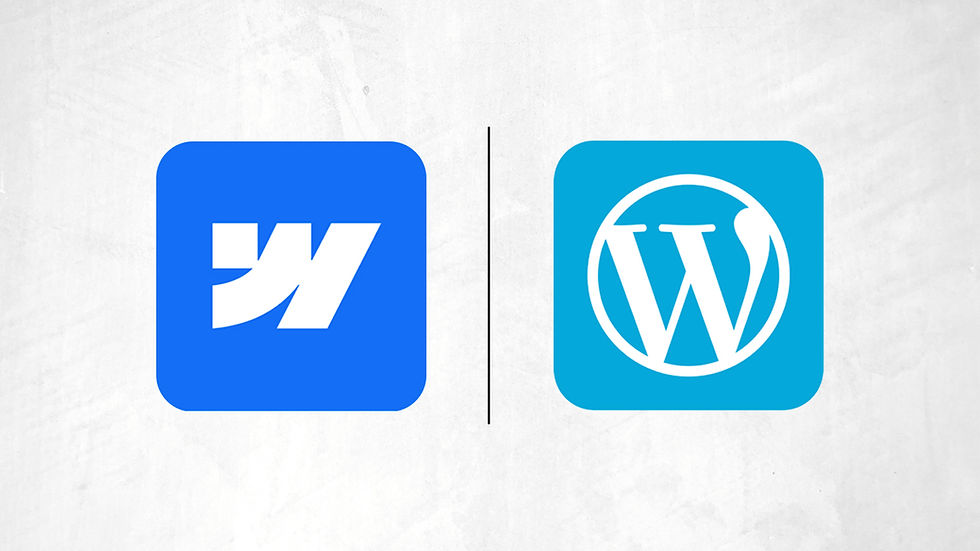Webflow vs WordPress
- Admin Msquare
- Mar 11
- 4 min read
Updated: Mar 13
Which Website Builder You Should Choose?

Choosing between Webflow and WordPress is like picking between a sleek, all-in-one design studio and a customizable, open-source powerhouse.
Both are powerful website builders, but they serve different needs. Whether you're a blogger, entrepreneur, or designer, this guide will help you determine which tool is the best fit for your website.
When it comes to website creation, WordPress has long been the dominant force, powering over 40% of the internet. Webflow, a newer but rapidly growing alternative, offers a visual-first, no-code approach. So, which one is better for you?
In this guide, we’ll compare their features, ease of use, design flexibility, SEO tools, pricing, and more, so you can decide whether Webflow or WordPress is the right choice for you.
Quick Comparison
Feature | WordPress | Webflow |
Ease of Use | Requires plugins & some coding | Drag-and-drop, no-code interface |
Customization | Highly customizable (requires coding) | Full creative control without coding |
SEO Capabilities | Powerful with plugins like Yoast | Built-in SEO tools, clean code |
Hosting | Self-hosted (you choose provider) | Fully hosted by Webflow |
Pricing | Free base, costs add up with plugins | Higher upfront, but all-in-one pricing |
Best For | Bloggers, content-heavy sites | Designers, agencies, and eCommerce |
1. Ease of Use
WordPress:
WordPress is relatively easy to install, and many hosting providers offer one-click WordPress download. However, the dashboard can be overwhelming for beginners. You’ll likely need plugins and some coding knowledge to fully customize your website.
Webflow:
Webflow is designed for intuitive, visual website building. Its drag-and-drop interface makes it beginner-friendly, and an AI-powered learning assistant helps guide you through the process. You don’t need any coding knowledge to create professional-looking sites. Plus, Webflow login provides seamless access to all its tools, making it an easy website builder for beginners.
Verdict: Webflow is easier to use, especially for non-developers.
2. Design Flexibility
WordPress:
WordPress offers thousands of themes and plugins. However, achieving a truly unique design often requires custom coding or hiring a developer.
Webflow:
Webflow provides complete design freedom. It allows for fully custom layouts, animations, and interactions and it’s +all without needing to write code. Webflow templates have the best website templates that provide professional designs that can be easily customized. That's making it one of the best website builders for creatives.
Verdict: Webflow wins for design flexibility.
3. SEO Capabilities
WordPress:
WordPress excels in SEO, thanks to plugins like Yoast and Rank Math. These tools guide users through optimizing content, keywords, and meta tags.
Webflow:
Webflow has built-in SEO features, including automatic clean code generation, customizable meta titles/descriptions, and fast page loading speeds. It removes the need for additional plugins and works well with website templates for SEO optimization.
Verdict: Both platforms are strong in SEO, but Webflow’s built-in tools make it easier for beginners.
4. Hosting & Performance
WordPress:
WordPress is self-hosted, meaning you’ll need to choose a hosting provider like Bluehost or SiteGround. This gives you flexibility but also requires you to manage updates, security, and performance optimization.
Webflow:
Webflow includes fully managed hosting with fast load times, automatic backups, and built-in security. However, you're locked into their hosting service and Webflow pricing structure, which may not be ideal for those looking for the best lower cost website builder.
Verdict: Webflow offers hassle-free hosting, while WordPress gives more flexibility.
5. Pricing
WordPress:
The WordPress software itself is free, but costs can add up with hosting, premium themes, and plugins. A basic site might cost $50–$150 annually, while advanced sites can exceed $500 per year.
Webflow:
Webflow’s pricing is higher upfront but includes everything you need. Plans start at $14/month for basic sites and go up to $39/month for advanced features. Webflow pricing for eCommerce plans ranges from $29/month to $212/month.
Verdict: WordPress is budget-friendly for beginners, while Webflow offers better value for designers and businesses.
6. Best Use Cases
WordPress is better for:
Blogging and content-heavy websites
Those looking for a low-cost solution
Users comfortable with plugins and some coding
Webflow is better for:
Custom-designed websites and portfolios
eCommerce stores that need unique layouts
Designers and agencies seeking full creative control
Should You Switch from WordPress to Webflow?
If you're currently using WordPress but feel limited by its design capabilities or frustrated with plugin management, Webflow might be a great alternative. Its visual editor makes custom website building much more intuitive.
However, if you're satisfied with WordPress and comfortable managing plugins and updates, there's no urgent need to switch. WordPress remains a powerful, flexible platform; especially for bloggers and content creators.
So, Which Platform Should You Choose?
Both Webflow and WordPress have their pros and cons. Your choice depends on your needs, skill level, and budget.
Choose WordPress if:
You’re a blogger or content creator
You want a cost-effective solution
You’re comfortable with plugins and some coding
Choose Webflow if:
You’re a designer or creative professional
You want full creative control without coding
You need a high-performance, custom website
In the Webflow vs. WordPress debate, there’s no single winner. Only the right tool for the job.
WordPress remains the best choice for content-heavy sites, while Webflow is redefining web design with its no-code approach.
So, whether you’re building a blog, an eCommerce store, or a portfolio, pick the platform that aligns with your goals and skills. After all, the best website builder is the one that helps bring your vision to life.




Comments